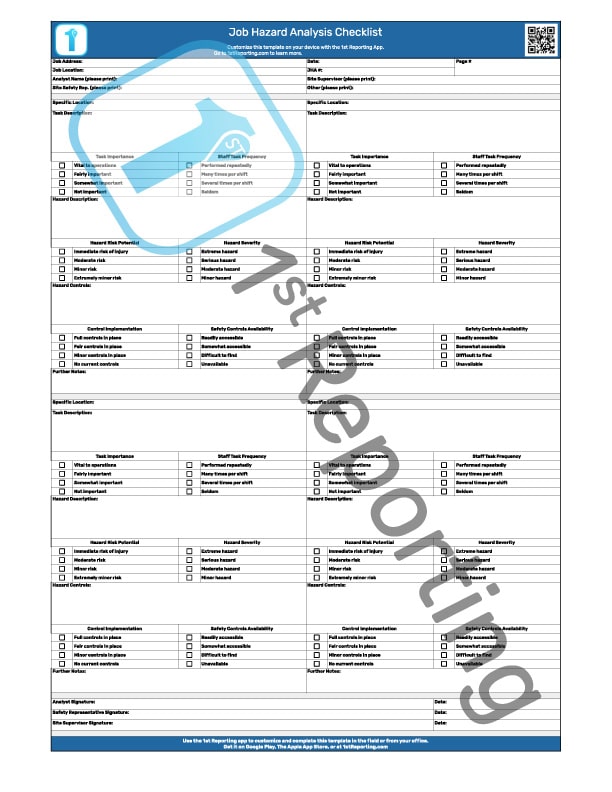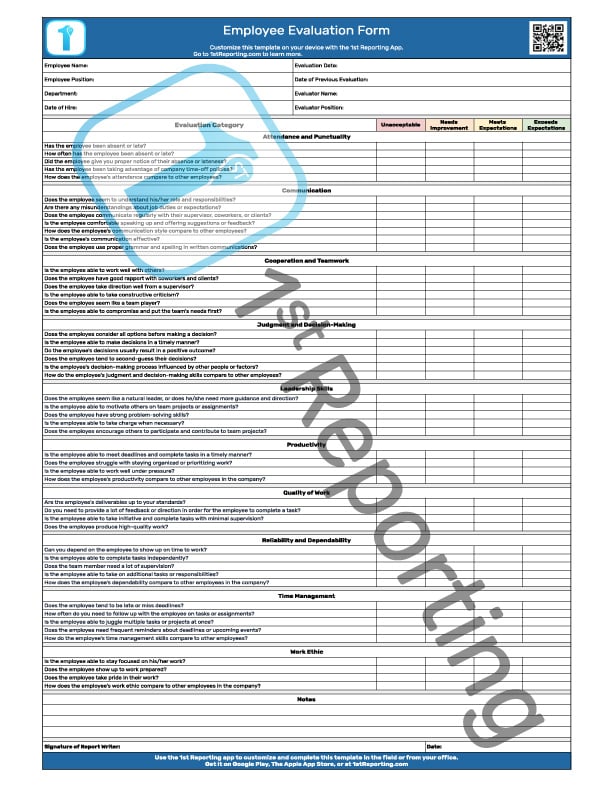Setting up standard operating procedures is a lot more convenient when utilizing a downloadable standard operating procedure template. At least, it will be a lot easier now that you’ve found this page with our free downloadable template.
The Downloadable Standard Operating Procedure Template for business (or any organization) is easy to use, easy for your team to understand, and simple to implement into your operations.
Let’s dive into a few critical aspects of the template to maximize your overall efficiency using our template. We’ve also got some great tips for you to aid in streamlining your operations – especially when it comes to using forms, checklists, audits, and templates, like the free Standard Operating Procedure Template provided here for you today.
Included In The Standard Operating Procedure Template
The SOP template we’ve created for you has six sections to break up the information for easier retrieval. Here are the explanations of each section.
Administrative
The SOP you are documenting will require designation to reveal the distinct differences from other SOP documents. In order to facilitate clean documents and thus information retrieval, specific considerations are included in this top section of the SOP template. The section consists of the possible division and department designations where the operating procedure is to occur. Similarly, we’ve included a place to add an SOP designation number if you have multiple operating procedures you intend to document.
Purpose, Introduction, and Scope of the SOP
Defining the parameters of your SOP in terms of the purpose and scope included in your procedure is paramount to the reader’s understanding of the SOP you are documenting. Similarly, there is a place to introduce the SOP for those who intend to read the procedure after its completion.
Definitions and Procedures
The following four component sections of the Definitions and Procedures section of the SOP template are described as follows.
Definitions
This section is available to define critical components to the procedure that may require a specific definition. It could be a name or type of equipment or tool required. Perhaps a program or other software components. This section provides a place to document specific definitions to ensure understanding of the SOP by those reviewing it.
Responsibilities
Responsibilities of those positions involved within the process are key measurables that require definition and explanation. The responsibilities section of the SOP template allows the SOP author to include said responsibilities.
Procedures
The primary body of the SOP is the defined procedure. The procedure section of the template allows for procedure documentation within multiple lines of available writing space on the template. However, some functions might include more than the template can manage. In this case, you can print off a second template to use as a supplementary SOP template or attach another document detailing further the procedures required. If attaching multiple documents is not in your preferred methodology, you may want to try the 1st Reporting app for a digital and mobile solution.
Forms/Templates To Use
Defining a specific procedure and following up with a step-by-step checklist for team members is an excellent way of managing a process. To maximize the quality and efficiency of results, utilizing the proper forms, lists, or documentation required to fulfill a process is vital. This area of the SOP template gives room for the SOP author to include the potentially various forms or documents that team members may require for adequate task completion.
How To Use The Standard Operating Procedure Template
General use of the SOP template is relatively straightforward. When your company or organization needs to implement position manuals or even build a proper health and safety manual, using an SOP template becomes necessary.
Using the Standard Operating Procedure Template we have provided you with here today is simple if you follow a few key steps:
- Download the template.
- Copy or print enough to cover your needs. We recommend making a few extra copies because one or two are likely to get tossed due to errors.
- Distribute to your assigned authors.
For a more in-depth procedure and information on how to write an SOP, check out our guide on writing an SOP here.
22 Actionable Tips For Using The SOP Template – Your Key To The SOP

Your key to successfully implementing the Standard Operating Procedure Template is to follow our tips.
We’ve done our research to pass on these valuable tips and strategies for not only implementation but aligning the SOP for future revisions and easier retrieval.
SOP Writing Tip 1 – Write The SOP For Everyone
Make it easy to read and use plain and direct language. S
OPs are not creative writing; SOP writers should focus on clarity and completeness.
SOP Writing Tip 2 – Start Early And Make Time For SOP Revision
Even if you have an excellent SOP already, it might need to be revised as time goes on or as new policies come into play. Remember, SOP revision is a continuous process, so plan ahead and work through the SOP periodically.
SOP Writing Tip 3 – Involve Your Team In SOP’s Creation
Your users will have more ownership over their job duties when they participate in SOP development instead of just being handed a list of procedures that they then follow from memory.
SOP Writing Tip 4 – Use The Right Tone In SOP Development
The correct tone is essential for a successful and professional SOP. The manner should be formal, business-oriented. Avoid using slang or localized synonyms for things.
SOP Writing Tip 5 – Use SOP Tools To Simplify SOPS Management
If your organization’s SOPs are constantly changing and evolving, saving time with an SOP app is a worthwhile investment. While many apps are available, 1st Reporting offers a complete mobile suite of report management tools that can help you get started today.
SOP Writing Tip 6 – Make A Draft First
Before you begin writing out your SOP, take some time to draft it first, so you have an outline of what will be included. If possible, ask some other people, including some business associates or new employees, for their input as well so you can get a fresh perspective on the SOP before you finalize it.
SOP Writing Tip 7 – Make It Easy To Update
Since SOPs are constantly evolving with businesses and having new procedures added, make sure that any SOP template that you use is easy to update whenever necessary. It will help save more time later instead of having to re-do parts of the SOP every time there are changes. SOP Template Examples should be easily editable in reporting platforms like the 1st Reporting app.
SOP Writing Tip 8 – Make Your SOP Actionable
When creating SOPs, it is essential to make sure that they are actionable. It means you need to include specific steps for each SOP section that managers or employees can easily follow. If an SOP calls for you to be within a particular location at one specific time, include how exactly you need to get there and when.
SOP Writing Tip 9 – Keep SOPs Current
It’s easy for SOPs to become outdated because many businesses introduce new technology or equipment into their workplace daily. Managers should reevaluate SOPs every so often and update them if needed. It could mean revising step-by-step instructions or adding additional information about new ones.
SOP Writing Tip 10 – Keep Your SOP Concise
Keep SOP concise as you write the SOP. Team members should easily understand sOPs and be free of ambiguity or confusing language. SOPs that are concise, clear, and unambiguous reduce the chances of your SOP being questioned or misinterpreted by those who implement it.
The SOP document contains various information, including personnel authorizations, responsibilities, safety precautions, and equipment operations. Make sure it is no longer than necessary to communicate what is required accurately and completely.
SOP Writing Tip 11 – Check Your SOP Template for Accuracy
Check your SOP template for accuracy. You should check SOP templates for spelling, punctuation, and grammar errors before the SOP is distributed to employees. This process helps avoid misunderstandings due to mistakes in your SOP document. When SOPs are reviewed at regular intervals, they can also help ensure your processes remain up-to-date with your business or industry changes.
Processes that are up to date and well-benchmarked offer a variety of benefits for any organization. So, ensure your SOP is accurate, so your metrics are also accurate. (source)
SOP Writing Tip 12 – Use Correct SOP Template Formatting
Use correct SOP template formatting. It would be best to plan the layout of an SOP before writing begins so that mistakes and rewrites are avoided. Using a predefined template like ours is a great place to start.
If you think that a customized template, with your company branding and more, is the way to go, try a customizable digital SOP solution as you’ll find on the 1st Reporting app.
SOP Writing Tip 13 – Break Complex Procedures Into SOP Steps
Breaking SOPs into SOP steps helps SOP writers with the writing process, and it also makes procedures easier to understand when they are implemented.
Imagine an SOP with a multiple-step procedure for a specific task, such as checking the oil level in an airplane engine. If this were a stand-alone SOP with no other SOPs attached, the SOP could be anywhere from five pages to 10 or more pages long. All of the parts involved would have their specific instructions detailing requirements for each part of the task.
In order to create logical groups within this SOP that would cut down on words and make SOPs quicker to implement, group similar tasks into SOP steps.
Continuing with the SOP example above, SOPs should include all parts of the required task as SOP steps. For instance, SOP writers could create SOP steps for draining and refilling the oil, cleaning and checking the dipstick, recording the reading on the dipstick, and verifying that no contaminants are inside or outside the engine.
Each SOP step would contain only one part of what should be done to complete a single aspect of a more significant whole task. This way, SOP writers can split up what was originally several pages into two or three easy-to-implement SOPs instead, one SOP for each step within them.
SOP Writing Tip 14 – Put The Most Important SOP Information In SOP Headers
SOP headers are an SOP writer’s way of organizing SOP information for SOP readers. As the SOP title, SOP headings should be placed at the beginning of each SOP step and provide a quick reference to what SOP step is implemented. It helps SOP writers avoid copying parts into other steps that deal with similar tasks or products. It also speeds up the implementation process because SOP readers can tell which task they need to complete based on the header alone without reading through everything in between.
The best practice for writing SOP headers is to list the three most essential pieces of information about each SOP step from most essential to least essential.
When SOP writers finish with SOP heads, they should organize SOP’s in the following order: headers followed by SOP steps. SOP writers must not include SOP steps within SOP headers.
SOP Writing Tip 15 – Provide A Measurable Goal
One of the easiest ways to ensure that SOPs are written with relevant detail is to provide specific goals for each SOP. An SOP that provides this measurable goal is more likely to be beneficial than one which does not.
For example, an SOP should always describe the result of a process. There will need to be enough information in an SOP for a worker who has no previous knowledge of the task to perform it correctly and thoroughly. But without defining what success or completion looks like, there’s a minimal way to mark their progress. It helps prevent SOP writers from including unnecessary information and prevents workers from feeling overwhelmed by too much detail.
SOP Writing Tip 16 – Set Clear Responsibilities
A key component of SOP writing is to be very specific when defining who will do what. It includes exact position titles and proper names, so there is no ambiguity. If you don’t specify the responsible party, then accountability could conceivably fall into someone else’s hands, which can cause problems in SOP implementation and management.
SOP Writing Tip 17 – Follow a Template
When creating SOPs, keep in mind that your team should follow your SOP template as closely as possible. SOP templates are designed to provide consistency for everyone who writes SOPs or uses SOP information. If you depart from the standard format provided by your company (or preferred SOP template provider), make sure you thoroughly document your reasons and any changes.
SOP Writing Tip 18 – Define Steps With Precision
The SOP format breaks SOP information down into a list of specific steps. Using this SOP format means each step is clearly defined and trackable as an SOP moves from writer to reader to worker and back again. SOPs that don’t use the SOP template are essentially documents without an outline. It makes them more challenging for SOP writers to write, harder for SOP readers to understand, and more difficult for workers to follow.
When writing an SOP, you want it to cover all necessary actions required but not go overboard with unnecessary information. There should be enough detail within the SOP. Hence, the responsible party knows how they will move forward but not so much detail that they already know what’s coming next or after that or that SOP writers can’t remember why they included some information and not others.
SOP Writing Tip 19 – Don’t Use Passive Voice
There are two types of SOP’s: active SOP’s and passive SOP’s. Active SOPs use the traditional “Do this, do that” format. At the same time, passive SOPs rely on vague statements like “Actions will be carried out” or convoluted phrases like “This step is necessary to complete before moving onto the next step.” Neither of these examples uses a practical specificity level, making them more difficult for SOP teams to follow because there’s no identifiable ‘doer’.
SOP Writing Tip 20 – Don’t Be Afraid Of Testing The Process
When SOP writers create SOPs, they should be testing the process as they write. SOP writers want SOPs to be easy to follow, and that means running through SOP steps for themselves before allowing anyone else to participate in the SOP writing process. SOP writing is not a group effort. If your team doesn’t understand what each step entails or why that SOP step needs following, nobody will know how to use that SOP information.
SOP Writing Tip 21 – Review All Feedback
After the initial round of feedback, you want to take a step back and look at your SOP with fresh eyes; this helps catch any minuscule errors that you might not have noticed during the initial review process.
Often when reviewing an SOP, the process reveals weaknesses that are sometimes easy to implement. Therefore, merely reviewing the feedback from a freshly written or updated SOP can benefit your organization.
SOP Writing Tip 22 – Make SOPs Available To All Workers
After SOP writing is complete, your SOP template should be available to all workers, not just those working on specific tasks or projects. You want SOP information to be readily available across the company, so everyone is up-to-date and knows what they need to do in an emergency or unique situation. It also ensures uniformity (everyone uses the same SOP information) around safety procedures, security policies, etc.…
Now that you’ve completely immersed into the world of SOP writing, you’re probably ready to give a mobile reporting solution a try to customize your SOP for your organization. Give it a try today with the 1st Reporting app, and you’ll be glad you did.






